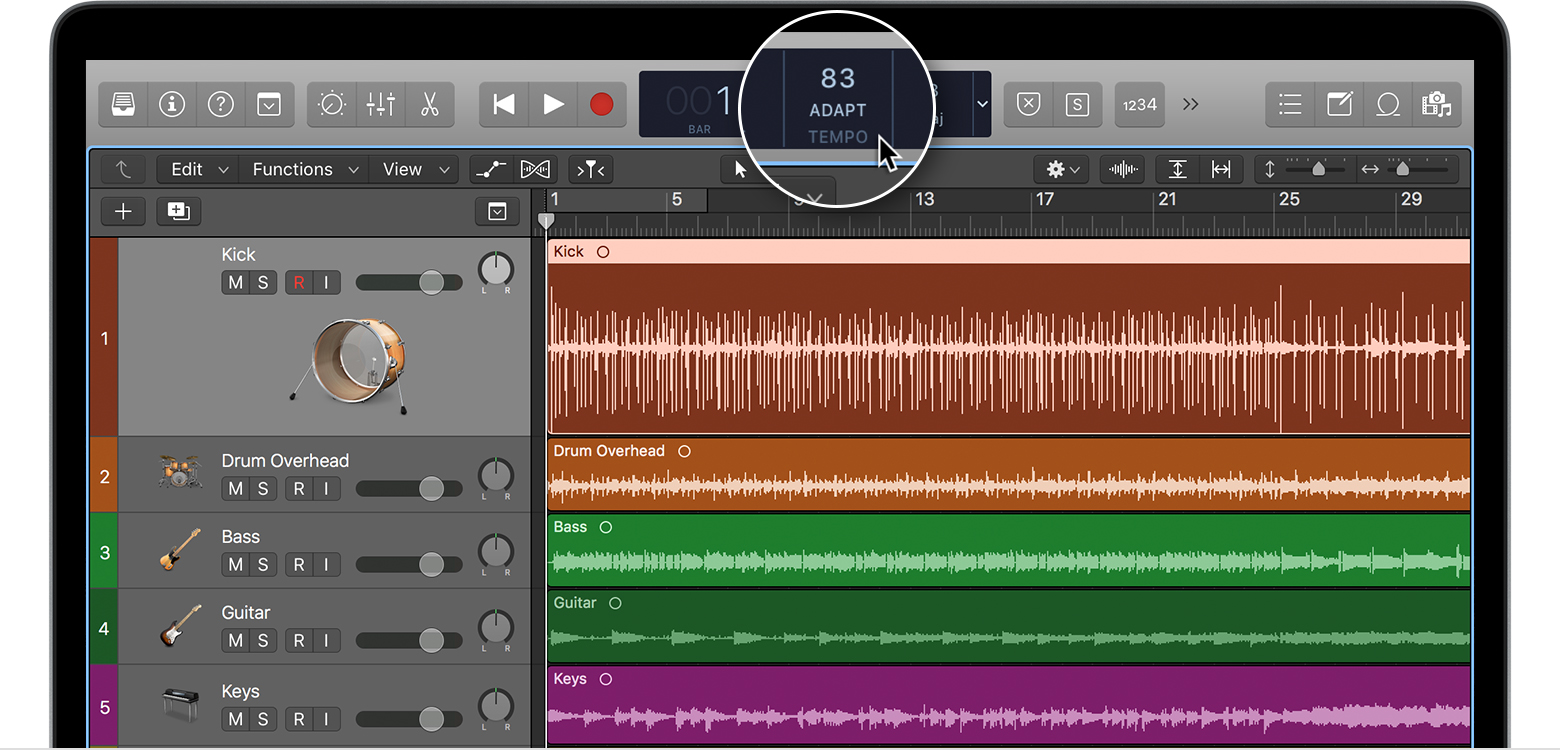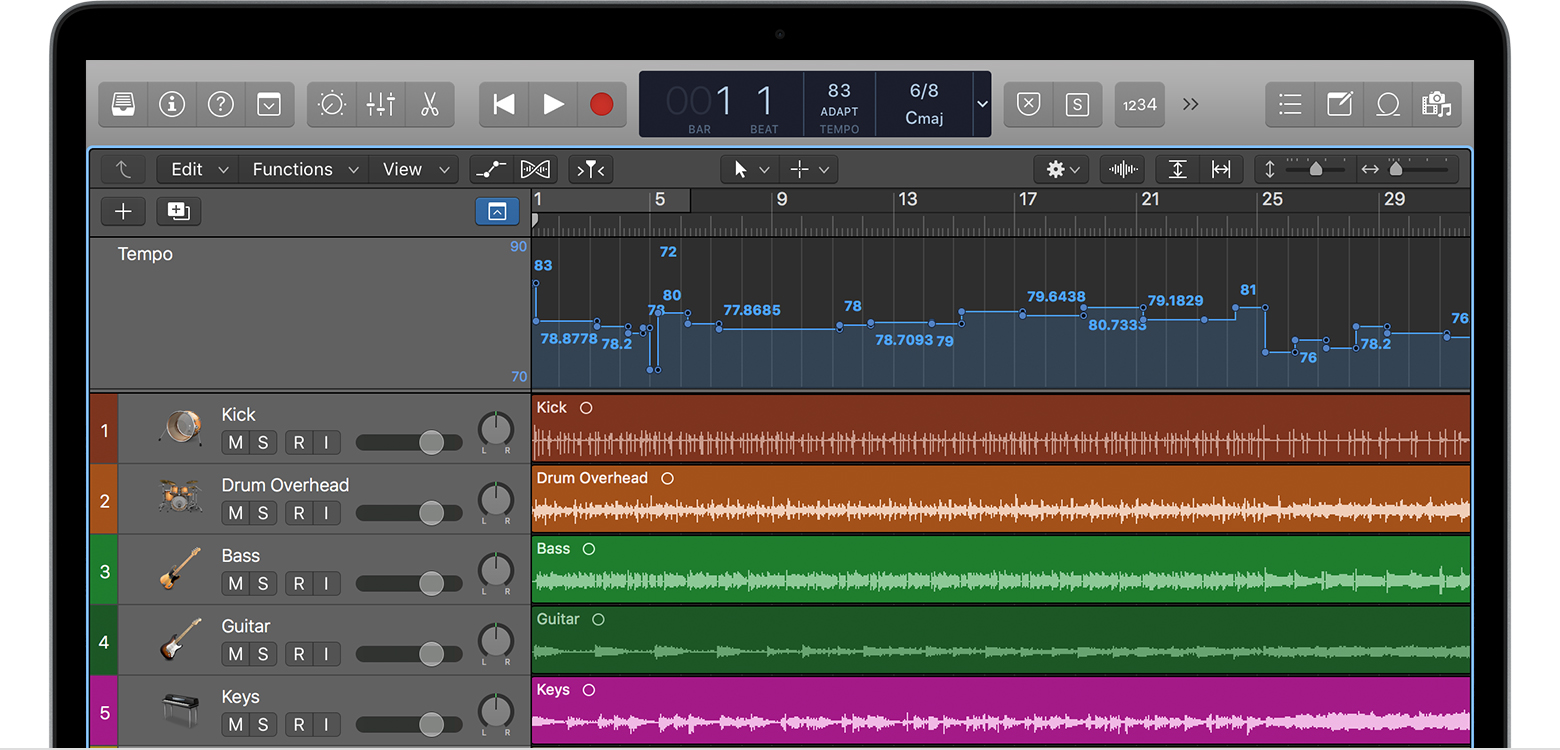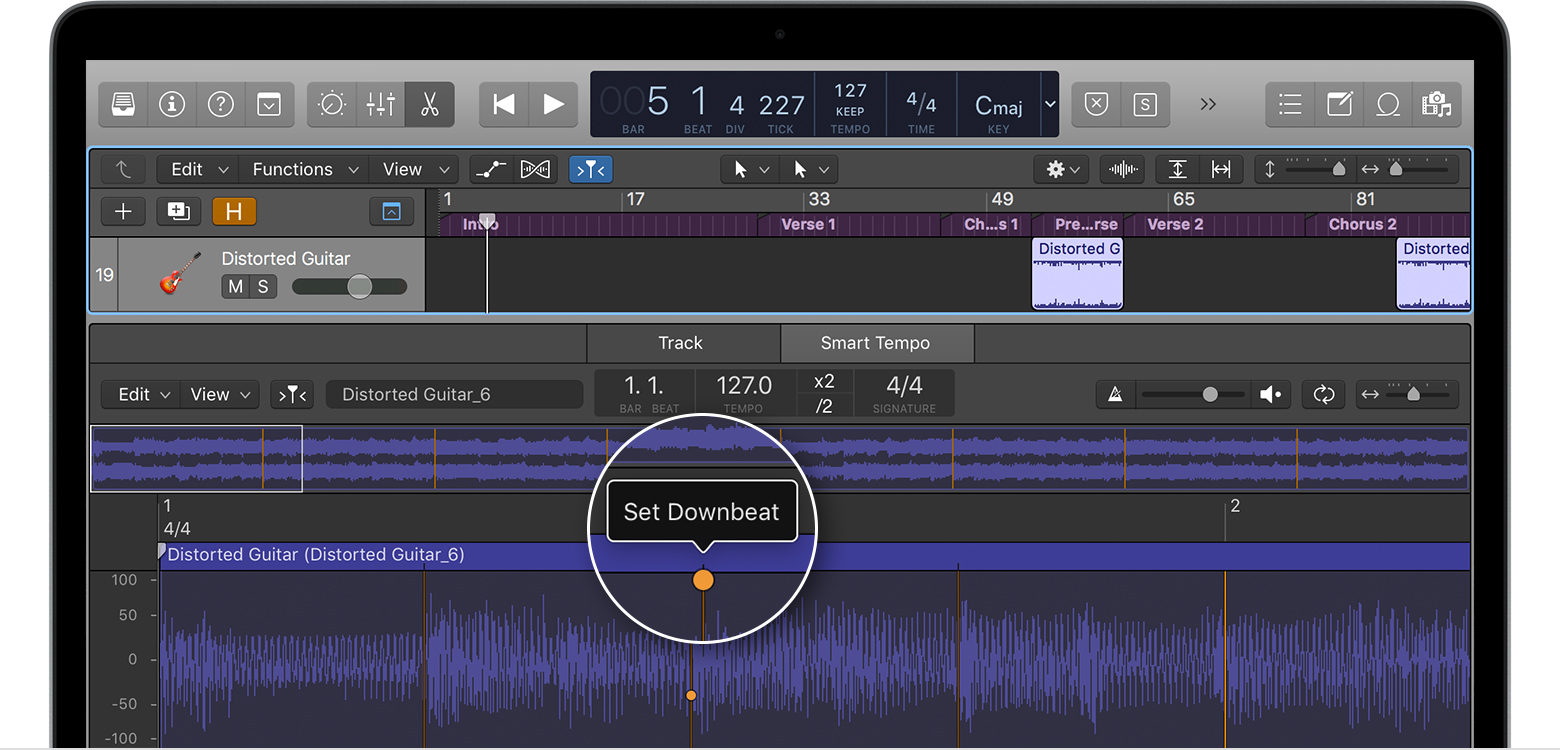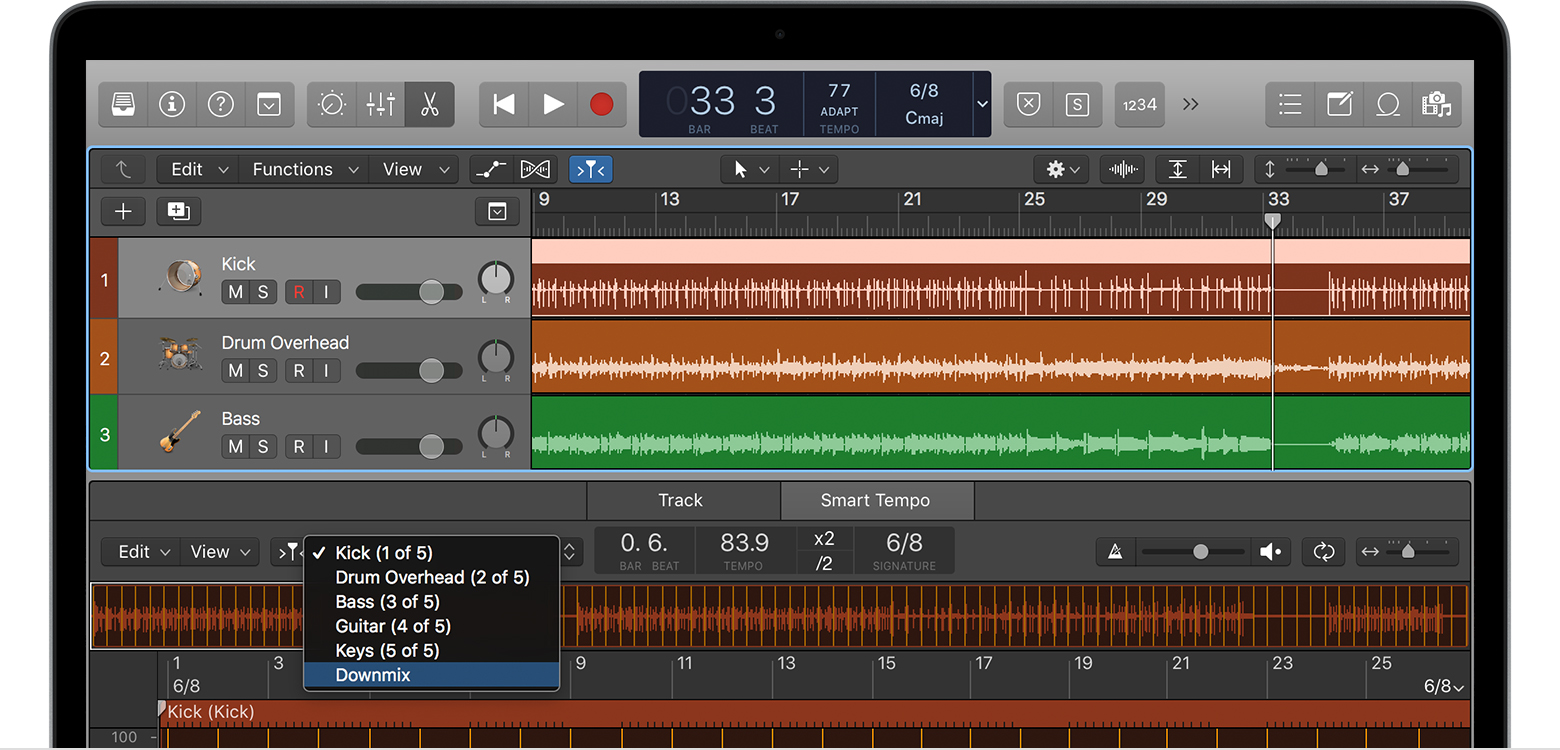How To Change Tempo Of Audio Track In Logic
Match the tempo automatically in Logic Pro
With Smart Tempo in Logic Pro 10.iv, tape a performance without the metronome and have Logic Pro adapt the projection tempo to friction match the tempo of the recording. Or, keep the project tempo and flex the recording to match it.
You tin can employ Smart Tempo when recording one or more sound, software musical instrument, or MIDI tracks. Smart Tempo includes three modes, Keep, Conform, and Automatic:
- Use Keep mode to employ the project's tempo setting for syncing all tempo-related fabric.
- Use Arrange mode to have Logic clarify and follow the tempo of a recorded performance or audio file.
- Use Automated mode to permit Logic Pro choose the style, based on whether or non a tempo reference (such as the metronome, or some other region) is in your projection. When a tempo reference is present, the project tempo is maintained. When no musical tempo reference is present, the project tempo adapts to lucifer the tempo of recorded or imported audio files.
To choose a Smart Tempo mode, click the Smart Tempo pop-up carte in the LCD.

Match the project tempo while recording
To match the project tempo to your performance while recording, use Adapt mode. Employ Adapt mode temporarily, when recording the offset tracks in your new project. If you record subsequent tracks with Suit way on, the tempo map will change based on the latest recording.
- Create a new project and add audio tracks.
- Choose Adapt from the LCD Tempo display. The Tempo rails opens so that yous can see how the projection tempo changes when recording, adding, or moving audio regions.
- Before you start recording, you lot can set some automatic actions Logic Pro volition perform just afterward yous've recorded the tracks. For example, Logic Pro tin can automatically trim the beginning of the tracks up to the get-go downbeat. Choose File > Project Settings > Smart Tempo, then select "Trim start of new regions" next to the "Set new recordings to" popular-up menu.
- Start recording. While you're recording, the projection tempo adapts to the recording. Ruddy lines in the region show detected tempo changes, and a tempo map appears in the Tempo track.
- When you lot're finished recording, press the Space bar to stop the send.
- In the dialog that appears, you tin cull to open the File Tempo Editor. With Smart Tempo Editor, yous tin preview the recording and make adjustments to the downbeat, tempo, and other tempo parameters.

When you motion or edit regions, changes in tempo follow regions to their new location. If you add together a Drummer track, other rhythmic instruments, or Apple tree Loops to the track, they'll automatically follow the tempo of the original tracks. If you did a multitrack recording and yous add tracks later, yous tin add the tracks to the set of tracks Smart Tempo uses to create the tempo map, and reanalyze the tempo.
If y'all import an audio file, the project tempo volition change to adapt to imported audio files.
Create DJ mixes with Smart Tempo
You can use Smart Tempo features to easily create seamless DJ-style mixes, where all the songs in the mix conform to the same tempo. You tin can create a mix in which all songs in the mix play dorsum to a pre-determined tempo, or play back at the tempo of the vocal yous imported first.
Create a mix that plays back at a predetermined tempo:
- Create a new empty project.
- Set up the Snap pop-upwardly bill of fare to Smart.
- Double-click the tempo in the LCD, so enter the tempo you want for the mix.
- Choose File > Projection Settings > Smart Tempo, then practise the following:
- Choose Keep Projection Tempo from the "Default for Project Tempo style" pop-up menu.
- Choose "On + Align Bars and Beats" from the "Set imported audio files to" popular-up menu. This automatically turns Flex on for imported files, and uses Smart Tempo analysis to quantize the downbeats and beats to the grid at the current project tempo.
- Import the first sound file. Logic Pro analyzes the file, conforming the file to the project tempo you set.
- To brand any adjustments in the Smart Tempo Editor, click Show.
- In the Tracks area, trim and move the song's beginning and end every bit desired.
- Import the next audio file. The newly-imported file plays dorsum at the project tempo.
Create a mix at the tempo of the outset vocal you imported:
- Create a new empty project.
- Gear up the Snap pop-up menu to Smart.
- Choose File > Project Settings > Smart Tempo, then practice the following:
- Choose Adapt Project Tempo from the "Default for Project Tempo mode" pop-up menu.
- Cull On from the "Set imported audio files to" pop-upward menu. This automatically turns Flex on for imported files.
- Import the first sound file. Logic Pro analyzes the file, and creates a tempo map.
- To brand any adjustments in the Smart Tempo Editor, click Show in the dialog. For example, you might need to set a new downbeat at the beginning of the file.
- In the Tracks area, trim and move the song's beginning and end every bit desired.
- Set up the Smart Tempo to Keep, then import the next vocal to the aforementioned track. The imported file plays back at the terminal tempo event of the first audio file.

Use Smart Tempo with multitrack recording
For multitrack sound recordings, Smart Tempo analyzes the multitrack audio files together to create the tempo map. To do this, Logic Pro creates a multitrack set, which you can edit at whatsoever fourth dimension. In the background, Logic Pro creates a downmix, which Smart Tempo uses to analyze the multitrack audio files. Use the downmix when refining the tempo analysis in the Smart Tempo Editor.
You can work with Smart Tempo and multitrack recordings iii ways:
- You lot tin create a multitrack recording and have Smart Tempo match the tempo while recording.
- You can import multiple audio files into a project and have Smart Tempo analyze them at the aforementioned time on import.
- You can select audio regions in the Tracks area of a project and have Smart Tempo analyze them together.
When creating a multitrack recording, or if you're importing multiple files into the Tracks area, prepare these options starting time.
- Choose File > Project Settings > Smart Tempo.
- Choose Suit Project Tempo from the "Default for Project Tempo mode" pop-upward carte du jour.
- When importing audio files, cull On from the "Set imported audio files to" pop-upwardly menu. This automatically turns on Flex for imported files.
Select and analyze multiple audio regions in the Tracks surface area
If you didn't apply Smart Tempo when creating a multitrack recording, you can clarify audio regions after you've recorded them.
- Select the audio regions that y'all desire to analyze in the Tracks expanse.
- Control-click 1 of the selected regions, and so choose Tempo > Create Smart Tempo Multitrack Gear up.
- In Contributes to Assay column of the Smart Tempo Multitrack window, deselect the regions you to exclude from the Smart Tempo analysis.
- Click Analyze. Yous can fine-melody the tempo analysis of private regions in the in the Smart Tempo Editor. Yous can also add and remove regions from the multitrack set and reanalyze them at whatever fourth dimension.
Edit the multitrack ready
After y'all initially clarify multiple regions, you tin edit the multitrack set to add or remove regions from Smart Tempo assay, then update the tempo assay. In the Tracks area, control-click one of the regions used in the multitrack fix, choose Tempo > Edit Smart Tempo Multitrack Set.
To reanalyze the fix, select or deselect regions to include in the tempo analysis, so click Update.
To create a new multitrack gear up, click Pause Up Set. Then, select the new regions you lot want to include in the Tracks expanse, Command-click one of the selected regions, and so choose Tempo > Create Smart Tempo Multitrack Set.

Employ Smart Tempo with software musical instrument and MIDI tracks
In a new project, create a software instrument or external MIDI track, set the Smart Tempo mode to Adapt, so record your operation. Logic Pro creates a tempo map, similar it does for audio tracks. Yous tin also utilise the Smart Tempo Editor with software musical instrument and MIDI tracks. Different with audio files, Logic Pro saves Smart Tempo edits directly to the MIDI regions.

Refine Smart Tempo assay and correct tempo detection errors
After yous record an audio region or import an audio file using Smart Tempo, you tin can refine the tempo analysis, and right whatever tempo detection errors with the Smart Tempo Editor.
For example, you can set the downbeats of an audio file if Logic Pro didn't detect them properly when you recorded or imported the audio file. In the principal brandish that shows the audio file waveform, identify the pointer over a beat out marking (indicated by red lines) you desire to make the downbeat (orange lines). A set of circular handles appears along the length of the beat marking. Each handle shows a tag describing the function of that handle. Place the pointer over the beat marker and click the Prepare Downbeat handle. You lot can also move and scale beat markers using the handles in the chief window.

The Smart Tempo Editor also includes other functions:
- To edit tempo data in the audio file, click the Edit pop-up menu. You lot tin can reanalyze the audio file, apply the tempo of a region to the project or utilize the projection tempo to a region, extend tempo changes, remove tempo edits made to the file, and more.
- To double or halve the tempo of the file, click x2 or /2 in the Tempo display. For example, you might've recorded an sound track in Adapt mode, and Logic Pro detected the tempo at double or half the tempo yous want.
- To preview the file, click
 .
. - To add a metronome to the preview, click
 .
. - To loop playback of the file, click
 .
.
With MIDI files, The Smart Tempo analysis for a MIDI region does not include time signature or downbeat location assay. Logic Pro automatically makes the starting time MIDI note event the downbeat.
Edit a multitrack set downmix
When editing a multitrack set in the Smart Tempo Editor, make certain to edit the downmix instead of one of the individual regions included in the multitrack gear up. In the Smart Tempo Editor, click the Filename pop-upwards card and cull Downmix. And so, you lot can fix the downbeat and perform other deportment on the multitrack set.

Published Engagement:
Source: https://support.apple.com/en-us/HT208458
Posted by: overstreethaterequed.blogspot.com


0 Response to "How To Change Tempo Of Audio Track In Logic"
Post a Comment